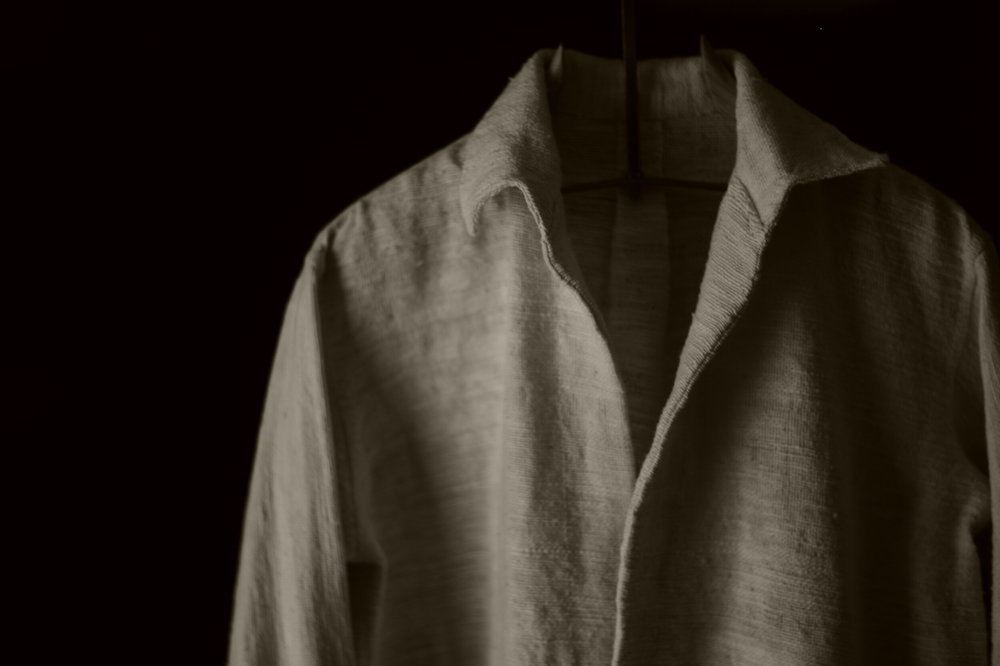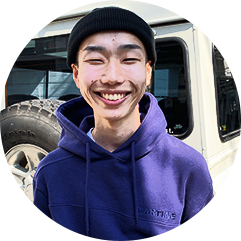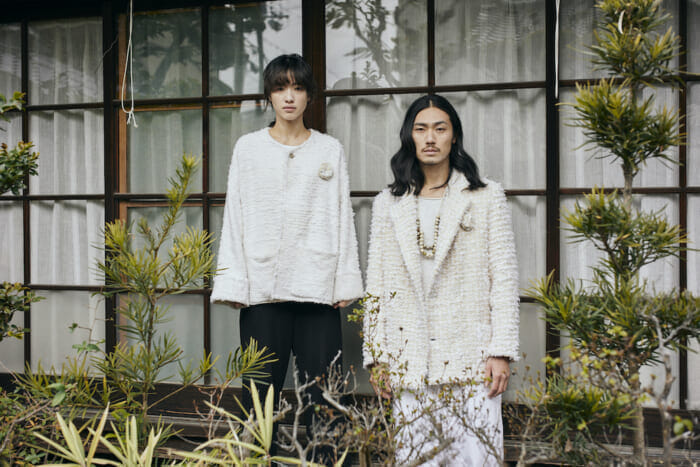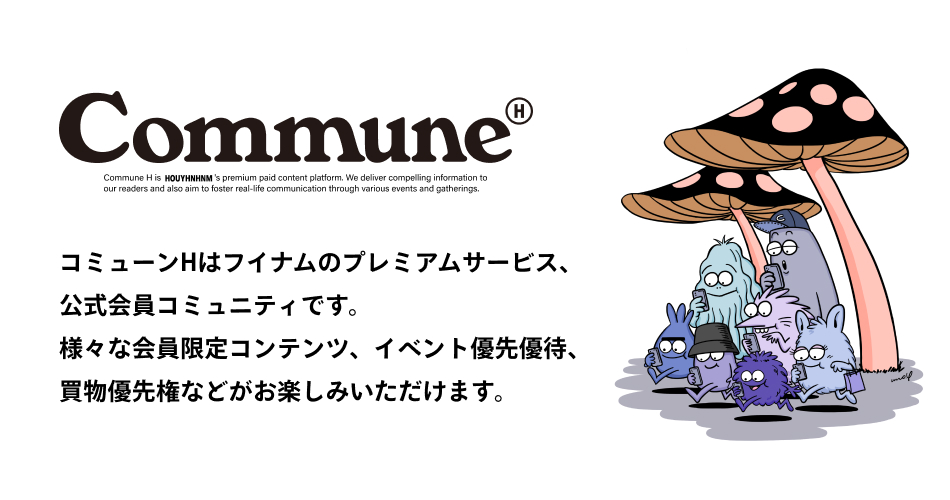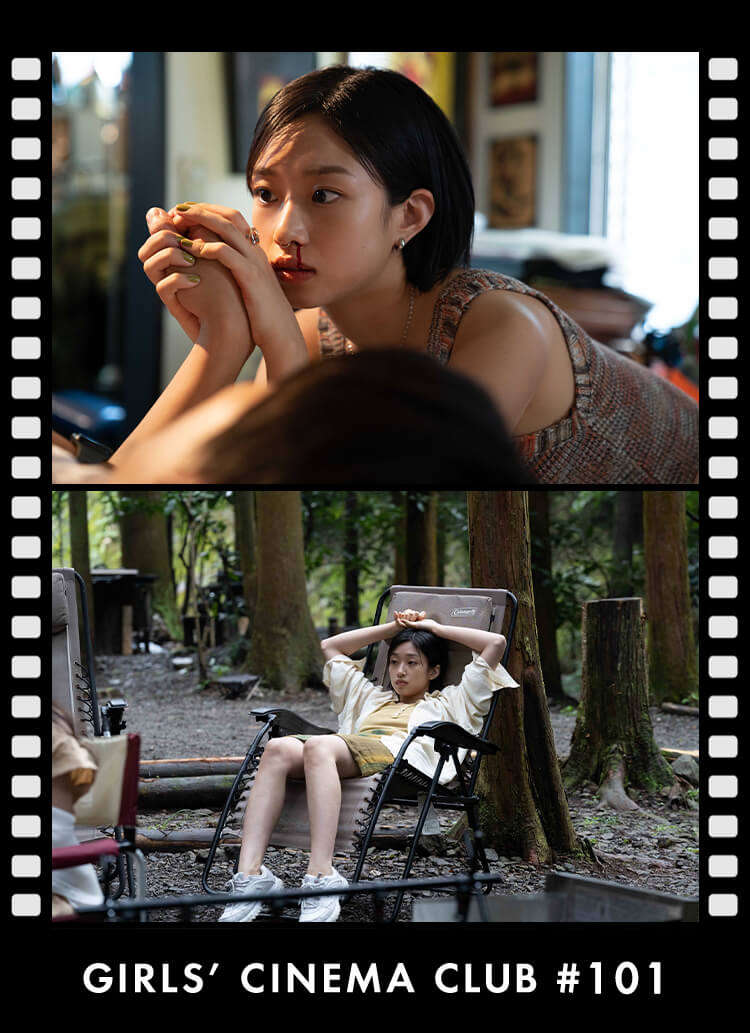While browsing Instagram, I was intensely attracted to one outfit that suddenly caught my eye.
Even though it was brand new, it had fraying and uneven weave, and even from the photograph, you could tell that someone's hands had been involved.
The brand is "tomo kishida.Blog on the official siteThe production process, which was documented in the "Mere Old Man", apparently involves the entire process of growing cotton and making the clothes himself.
To get a fuller picture of Tomo Kishida's out-of-the-box approach to making clothes, we spoke with the creator, Mr. Kishida, to find out more.
PROFILE
Born in Osaka , 30 years old. After majoring in architecture at university and graduate school, he worked as an engineer at a manufacturer. While working, he attended the Sunday course at Vantan Design Institute for one year and started "tomo kishida" upon graduation. Currently based in Osaka, he regularly holds pop-up events in various locations.
ooooooooooooooooooooooooooooooooooooooooooooo!
. I want to make something that is filled with people's passion for life.
Tomo kishida" can you start by telling us a little bit about what happened before you started "tomo kishida"?
. I went on to graduate school, but my major was architecture. After graduation, I worked as an engineer for a manufacturer for about two years, and at the same time, I took a Sunday course at "Vantan" for one year to learn how to make clothes. . So I was not a fashion person at all.
How did you make the transition from architecture to the world of fashion?
I have loved making things since I was working in architecture, but once I entered the corporate world, I was only involved in one part of the manufacturing process. It was interesting because I was working on the cutting edge of technology, but I wanted to create something that was more passionate about people.
I went to an internship program with the intention of making furniture, but I realized that although I liked making furniture, I didn't really like furniture that much. Then I thought, "What is it that I really like?" I decided to try my hand at clothing and enrolled in Vantan.
You always liked fashion?
When I was in high school, I didn't have much freedom in my appearance due to dress restrictions and hair inspections. . Perhaps in reaction to this, I fell in love with clothes.
I think it is common for aspiring designers to go to fashion school after graduating from high school, but why did you go on to graduate school and then work for a company?
Since I was in a preparatory school, it was the norm for me to go on to a four-year university and then work for a company. Therefore, going on to a vocational school was not an option for me.
Since I had gone all the way through graduate school, I wanted to find a job at the best company I could, so I found a job at a relatively well-known company. However, I felt that I was living with a part of me that was being held back. Once I got a job, I felt satisfied that I had fulfilled my responsibilities to some extent in relation to my parents' expectations, and from there I started thinking about what I wanted to do.
Q. How did you start your brand after studying dressmaking at "Vantan"?
I started attending Vantan in 2017. It wasn't that I was confident that I could succeed, but I could see the path I wanted to take. Then I decided to do it, and in 2018, I started the brand with a lot of momentum. I quit my job at the same time I graduated from Vantan and bought a loom with my severance pay.
. It's not easy to make the transition from being a stable salaryman to a designer, and it's not easy to start a brand upon graduation. It is not easy to start a brand upon graduation. Did you feel anxious?
I was ready to do it. I had a clear idea of what I wanted to do, and I decided to bet my life on it for once. . Besides, if I didn't want to do what I wanted to do, there was absolutely no need for me to quit my job and start my own brand, so I didn't think about training somewhere in particular.
ooooooooooooooooooooooooooooooooooooooooooooo!
The driving force is doubt about common sense.
Tomo Kishida: Let's talk about "Tomo Kishida" from here. . First of all, please give us a brief explanation of the brand.
Tomo Kishida has two labels, "uni iroikas" and "land to skin. Uni iroikas" is a label that makes clothes by rip weaving, while "Land to Skin" is a label that handles everything from cotton cultivation to the making of clothes by the weaver himself.
Incidentally, my feeling is that Tomo Kishida is not a brand, but rather a project. I think that TOMOKISHIDA is a platform to organize the projects that I want to do. Originally, I started "Uni Iroikas" as a Sakiori brand, but as I started working on it, I realized that "I don't want to be a brand.
. In any case, we are doing amazing experimental things, so I feel more comfortable with the position of a project rather than a fashion brand.
long vowel mark (usually only used in katakana) Blog documenting the process of making the clothes on the official siteI had the impression that what "Tomo Kishida" is doing is indeed distinct from other fashion brands.
Of course, I also like fashion, and I still watch runway shows. I have a longing for fashion and collections, and I have always wanted to try my hand at it. On the other hand, I had my doubts about the conventional methods of collection brands, which change from season to season, and so I decided to take the best use of my background as a Japanese and as a person who has lived my life to the fullest, and that is how I arrived at my current activities.
Why do you grow cotton, weave cloth, and do other things that most designers don't do?
When I heard in the "Vantan" class that a garment is finally made through a pattern maker, a factory, and a fabric store, I wondered if it was really necessary to do that. I thought to myself, "What is the point of practicing sewing in school? I had doubts about such common sense, so I thought, "It doesn't have to be that way," which is probably the biggest driving force for me to create my brand.
So I decided to do all the sewing myself, and rather than look for a good fabric store, I decided to do the weaving myself. Since I had quit my job and jumped into this career path, I decided to do it the way I wanted to do it, without worrying about what was normal in the world.
I see that your creations reflect your reaction to the fact that you have been following the norms of the world so far.
I think my strength is that I am a nobody. I am not a designer, a craftsman, or a farmer . . that's why I think I can do it all. If I become a designer, I may not sew clothes, and if I become a craftsman, I may neglect design. It's a bit philosophical, but I think it's because I don't belong anywhere that I can belong to everything.
Let's start with "Uni Iroikas. Sakiori weaving is a technique of ripping old cloth and reusing it as material for textiles.
. I had started teaching myself Sakiori while I was attending "Vantan". When I was practicing sewing at school, I wondered why so much cloth was thrown away as garbage. I thought, "I'm not making anything important, but all I'm doing is creating garbage. Then I thought it would be great if I could make something cool out of what would otherwise be trash.
I brought the leftover cloth home and made a stole on a tabletop loom that I happened to have at home. When I brought it to school, the teacher said, "This is a weapon that only you have. Let's make clothes with it. People around me were like, "That's impossible," but I thought Sakiori weaving was very interesting.
Of course, from a business standpoint, it was impossible, and I knew it was impractical, but I just had to do it. Technically, it is an old method, not cutting-edge or anything, but I found it interesting.
It's interesting that no one else is doing that old technique now.
In the past, that was the norm, and on the contrary, it was the only way. Nowadays, things are moving in a more and more rational and business-oriented direction, and I feel that the essence of things is being lost. That is why Sakiori fits well with what I want to do. SAKIORI is sometimes used in a folk art sense, but no one uses it as a fashion item. I think it is interesting that the way it looks is fashionable, but the technique is craft-like and folk art-like.
What kind of clothes do you make at "Uni Iroikas"?
The key word for "urchin iroikas" is "nobody," as I mentioned earlier. The brand name "urchin" is a combination of the English word "un," which means "negation," and "uni," which means "uniform. Also, "iroikas" is "sakiori" when called backwards. Just as I am a nobody, I wanted to make clothes that are like uniforms but not like uniforms, and that do not belong to any genre, so I named this brand "iroikas". I receive scraps from fabric makers, weaving factories, clothing schools, and fashion brands, and I make clothes from them by Sakiori.
ooooooooooooooooooooooooooooooooooooooooooooo!
Clothes made by a family .
K.F.: You are involved in the entire process of your other label, "Land to Skin," from growing cotton to turning it into clothing, aren't you?
Just as I wanted to make Sakiori from the fabric, I also wanted to make yarn. Luckily, my grandfather is a grape farmer, and he had an extra field where he could grow cotton. I have grown cotton for three seasons so far, and I am now in my fourth season.
A: I don't think there are many ordinary clothing makers who are involved in cotton farming.
When I actually tried it myself, I realized that it is extraordinary that so much clothing is produced in the world with this production method. I work with my family, and even so, the amount of cotton we get is about 10 to 20 kg per year. It takes about 500 grams to make one garment, so we can only make about 20 garments. . So I despaired of the amount of clothes in the world. I had a gut feeling that this kind of thing was happening all over the place, as you might expect when you hear about labor problems in fast fashion.
. Also, speaking for myself, I feel that my concept of fashion has changed. When you grow something from a seed, you don't feel like you are making clothes. Clothes are just an agricultural product made from the bounty of nature. I was surprised to find that I had developed such a sense.
Please tell us about the process of making the clothes.
The seeds are planted in May, harvesting begins in October, and the cotton is fully harvested by January of the following year. After the yarn is made, it is woven, and after the fabric is made, it is sewn, and then it is made into clothing.
So, it takes more than a year to go from seed to clothing.
Yes . The further back you go in the process, the more time is needed. Weaving the fabric and sewing by hand are easy-to-understand processes, but the work that precedes them, such as spinning the threads, preparing the fibers, and setting the threads on the loom one by one, is the unseen, behind-the-scenes work that takes time and is not so simple. I hope that through my activities, people can understand that there is a lot of work involved in making clothes.
I feel that if people understand the process of making clothes, they will have a different attitude toward clothes.
I would be happy if they would take a little better care of the clothes that they would normally wear. It is not that fast fashion is bad, but just because it is affordable does not mean that the clothes should be treated roughly. If people feel attached to whatever clothes they are wearing, I think my activities are a success.
In your blog, you described making clothes as raising children, and I think I understand what you mean when you say that.
I don't have children, so I don't know, but I think it must be similar to the feeling one gets when giving one's daughter in marriage. After a year and a half of work, I have no desire to sell them from a business standpoint. So, at the moment, I am able to make only a few items a year, and I feel very happy that I am able to deliver my clothes to people who understand my activities. I don't want to succeed as a businessman, so I hope that my philosophy can be conveyed from a long-term perspective.
Tomo Kishida is not pushing the sustainable side of the fashion industry, is it?
I think it is very uncool for a brand to push the idea of sustainability. It is not something that should be advertised on purpose, but rather something that is commonplace in my mind. The reason I started Sakiori was because I felt that it was a waste of discarded fabrics, which is a natural feeling. However, I think it is important that the word "sustainable" is now in vogue so that the commonplace can become commonplace.
However, for my part, I don't want people to be aware of my brand by highlighting its eco-friendly aspects, but rather to enjoy my clothes as a romantic idea. I want people to enjoy clothes from a romantic point of view. I think it is romantic to make clothes from seeds. I think it is essential to be sustainable in this way of enjoyment.
What materials do you emphasize in your creations for both "Uni Iroicus" and "Land to Skin"?
I believe that materials are everything. I have the sense that I can see what I want to make by touching the material. At first, I weave fabrics with the idea of making this kind of clothing, but after weaving, I often change my mind and say, "I think I should make this kind of clothing. It is as if the material is the source of the design.
. Of course, the fabrics are important, but I felt that the clothes you make, such as the buttons, are very detailed.
. My partner is a potter, so I have him make ceramic buttons for me. I don't use ready-made parts because I can't find anything I like.
In that sense, the clothes are made by a family.
It may look like I do it all by myself, but my sister helps me weave the fabric, my father helps in the fields while I am away on business, and my family is a big part of my life. I can't do everything on my own.
. If I hear such a story, I can't think of buying Mr. Kishida's clothes with a half-hearted attitude.
I hope you think so. In fact, at exhibitions, my priority is not to have customers buy clothes, but to have them understand my activities. Even if they buy the clothes, I feel frustrated if they do not understand the essence of my activities. However, of course, we are truly grateful to the customers who purchase our clothes. . especially since I really could not afford it financially when I started my activities (laughs).
You are very particular about the way you sell your products.
I hold pop-ups on a regular basis, and I try to stand in the stores myself and tell people about the clothes. I am not satisfied with the idea of distributing clothes to stores and ending my responsibility there. I want to be responsible for the delivery of the clothes to the customer and beyond. That is why I deliver the clothes directly to the customers by my own hands.
Now, I am gradually wholesaling to stores, but I can only entrust this to people I can truly trust.
. Since you can only make a few pieces a year, it's great that you can deliver them to people who truly share your passion for your craftsmanship.
At first, I was in a hurry to get more people to know about it, but that is no longer the case. There is a limit to how much I can produce, and I don't think it is necessary to reach everyone. It would be a waste to end up with something that is just a fad, so I am conscious of that.
If I wanted to do "Tomo Kishida" as a business, I wouldn't spend this much time and effort, but I'm not looking to make money. If I continue to believe in my initial feeling that I want to do this, I feel that it will gradually start to sell. I'm having a hard time right now (laughs). I think that trying to sell in a strange way is the worst thing you can do, so I want to stick to the resolution that I have decided to put my life on the line for until the end. If I have to give up on business, I will quit once and for all.
This is the third year for the brand. Has anything changed since its establishment?
. I feel that I have become more relaxed in a good way. In the beginning, life was tough, and I was running as fast as I could, not knowing what was right and what was left. Last year, Corona became popular, and I think I was able to look at things from a bird's eye view. I used to think that I had to make clothes using either "Uni Iroicus" or "Land to Skin" for branding purposes, but for the collection I made this summer, I used just hand-woven fabrics. It was a new feeling for me to be able to make something that I thought was beautiful at that time of the year.
Conversely, what has remained the same?
. There was a time when I thought it would be more beautiful if I had someone else do the patterns for me. There was a time when I thought it would be more beautiful if I had someone else do the patterns, but I thought that doing it myself, even if I am not very good at it, would make sense 10 to 20 years from now.
. and I haven't changed my mind about trying new things. . I am going to start silver jewelry this year, and I am going to school now.
Lastly, what are your plans for the future?
I know roughly how many clothes I can make in a year, so I can see the ceiling in terms of business. . So I don't think about growing in terms of business at all. . If I need money, I will do something else.
. So, first of all, I would like to build a solid foundation for what I am doing now. On the other hand, I also want to expand the range of my brand, and most recently, I would like to launch the silver jewelry line I mentioned earlier next year.
. also, I would like to expand the scope of my activities to overseas. In fact, many of our projects have been stalled due to the Corona Disaster, but we have been approached by stores overseas and some are in the process of being produced. . I believe that if we go abroad, Japanese people will realize the potential that Japan has.
There is a lot of talk about environmental issues nowadays, but there have always been environmentally friendly methods, such as the Sakiori culture, that Japanese people have forgotten. I wondered how I could make people aware of this, and I thought that if my work could be recognized overseas, the home of fashion, it would naturally reach the Japanese people. I would also like to know how well my work is accepted overseas.
tomo kishida
【Land to Skin 2021 exhibition]
Dates: 12/10 (Fri.) - 12/12 (Sun.)
Venue: acht8
Address: TM Daiichi Building B1, 5-1-2 Toyooka, Iruma-shi, Saitama
Hours: 12:00 - 21:00


